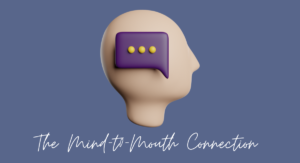One of the things we’re always aiming for when we speak is to be clear. Sometimes to be impactful as well, but definitely to be clear.
[Video content is below, too, if you prefer to watch.]
And one of the key reasons that we don’t achieve this clarity goal is when our mouth is ahead of our mind: we don’t have a strong mind-to-mouth connection.
When our mouth is running the show, any of these issues can happen. I’m sure you’ll recognise yourself in at least one of them! Most people do at least one of these on a regular basis.
We:
- Ramble
- Rush
- Um and ah
- Throw out these favourites: “you know” and “like” or “right?”
- We stumble and fumble
We may even say something that is inappropriate for the audience or context that we’re speaking in, but it’s too late to take it back!
When we have a strong and connected highway between our mouth and brain, we give ourselves the time and space to avoid the challenges and choose our words effectively.
If you picture that connection for a moment, we’re aiming for a three lane highway, not a narrow laneway.
So, what’s going to work if any of those above issues are a problem for you?
ACTION STEPS
Visualise
The first one, and this is one of my favourites, is that you visualise, or even better, feel the words forming in your mouth as you are thinking them.
This is going to slow down your delivery and give you the time to choose and to think as you’re speaking.
And when I say literally feel, I mean you’re putting your attention, as you speak, onto your lips and tongue, and feel your mouth moving as you say the words.
Pause
The second way that you can create a stronger mind-to-mouth connection is to pause between your ideas, to give yourself time to catch up, and gather before you go again.
By the way, if you are in a situation where pausing won’t work because you know you will be talked over or cut off, you don’t have to pause. The first technique will work extremely well. Because it’s going to slow you down without the pauses being necessary.
This is something to practise and to test – it probably won’t work if you try it during a presentation without testing it first, and you may find it off-putting and lose your words initially.
And of course, you won’t (and couldn’t) do this all the time: it will drive your audience to distraction if you’re too slow and deliberate!
So, it’s worth practising and it’s absolutely worth using as a technique IF you’re in a situation where it’s extremely important to choose your words with care, and not say the wrong thing.
(And I tested this exact technique today as I dictated this post to my wonderful assistant Jasmine – ha! Definitely saved her from editing a rambling, messy page.)



Leave a Reply